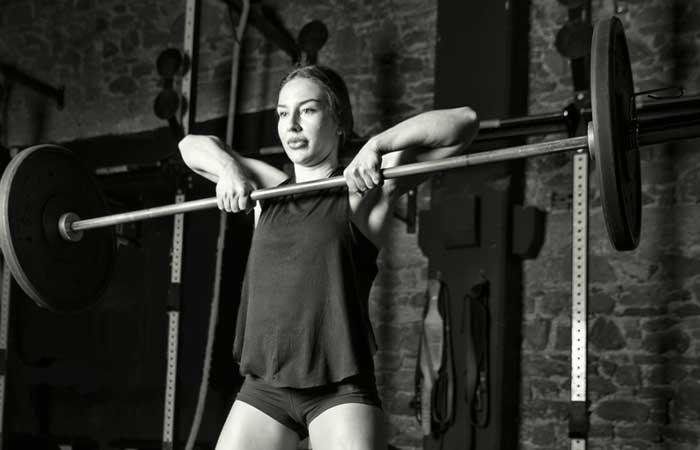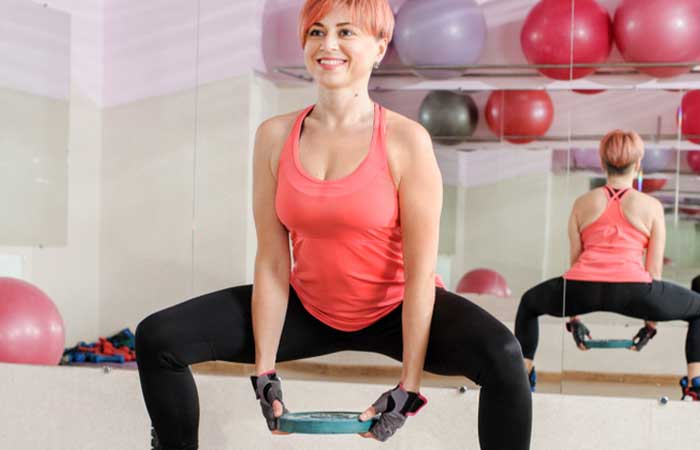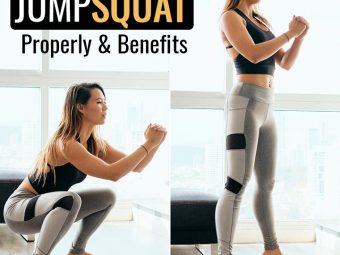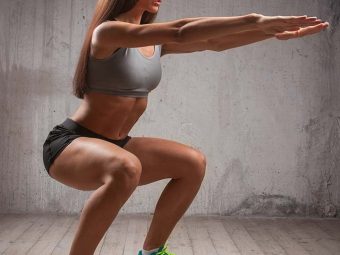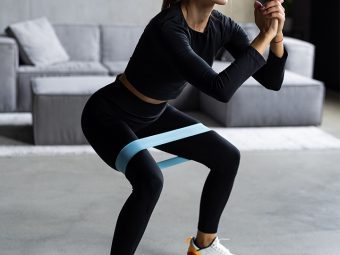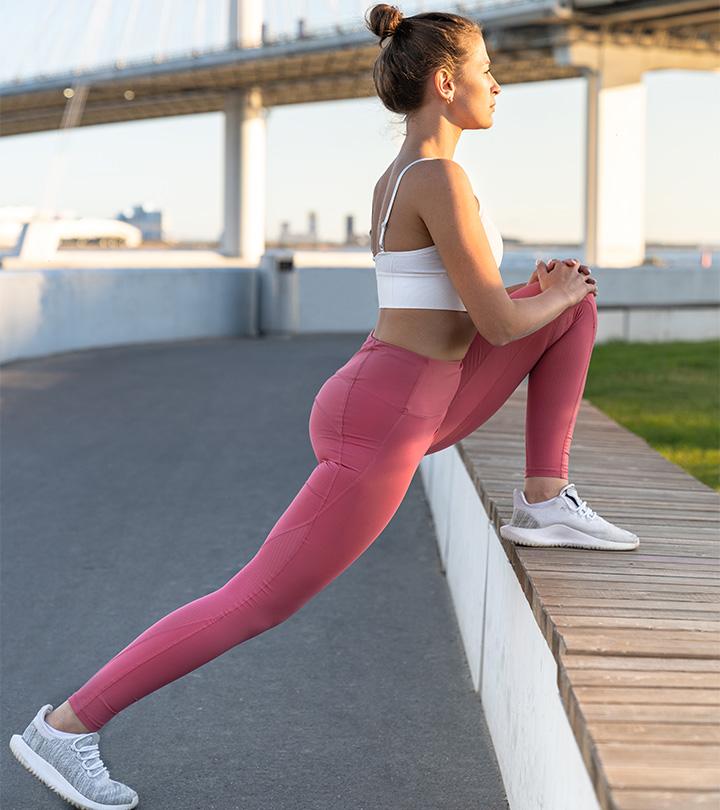How To Do Sumo Deadlifts: Variations, Benefits, And Common Mistakes
Produce top gains with a functional strength training exercise that works the entire body.

When it comes to strength training, deadlifts are considered the king of weightlifting or powerlifting exercises. However, sumo deadlifts rarely get fair recognition as they are considered weaker due to their fewer range of movements. But this fantastic variation can help enhance your stability and balance.
This exercise involves a broader foot stance that not only helps you lift more weight, but is also kinder to your lower back. It is worth considering whether you want to include it as a staple in your workout routine or perform it as an easy alternative when you lack motivation. Keep reading to learn more about this multi-muscle activity, its benefits, and the common mistakes you might make while doing it.
 Sumo Deadlifts
Sumo Deadlifts- Frequency: 1–2 times per week
- Benefits: Improve hip mobility and increase lower back strength.
- Equipment Needed: Barbell and workout gloves.
- Space Required: Small area
- Assistance Required: No
- Who Should Avoid: Anyone with a history of back or hip injuries and knee pain.
In This Article
What Are Sumo Deadlifts?
Sumo deadlifts are a deadlift variation that uses a broader foot stance, similar to that of a sumo wrestler. The movement requires the lifter to grip the bar with their arms in the sumo squat stance, with their toes under the barbell and pointing slightly outwards. This kind of barbell exercises allows more leg strength and makes it easier for the lifter to pull heavy weights without straining their lower back. You can go for this deadlift variant if you want to lift more weight without affecting your lower back and spine.
“As with any new exercise, it’s important to start light and focus on proper form before adding weight,” says Personal Trainer Hannah Shine.
Now that you know what sumo deadlifts are, let us find out what muscles they target.
What Muscles Do Sumo Deadlifts Work?
Like most other deadlift variations, these majorly work the glutes, hamstrings, and back. However, some distinctions make it worth the effort. They focus more on the inner thigh muscles. Here are the primary and secondary muscle groups these deadlifts work on.
Glutes
These lifts follow a posture with your feet set wider and turned outwards. They work on extending your hips and raising your body. Since the movement of the leg away from the body midline is higher, sumo deadlifts work the glutes to a high degree (1).
Lower Back
The spinal erectors are among the critical limitations for most people during a heavy workout. Sumo deadlifts work on developing these lower back muscles by keeping the spine stable while one pulls up the weight. Further, the shearing load on the lumbar spine is lesser as the torso is more vertical during the lift (2). Thus, sumo deadlifts are better for your back.
Quadriceps
This deadlift variation works to extend your knees to ensure the lift starts off the right foot. The lift setup requires a lot of quad strength to get it going. So, if your quadriceps are not well engaged, you may end up with some unwanted adjustments that may make the deadlift difficult.
Secondary Muscles
Apart from the primary muscles mentioned above, sumo deadlifts also work some secondary muscles. For instance, your hamstrings are engaged when you perform the sumo deadlift. The same goes for your adductors, trapeziuses, and forearm flexors. However, if you want to target these muscle groups more aggressively, choose other variations like conventional and sumo Romanian deadlifts.
Let us move on to the next section to understand how you can perform these deadlifts with ease.
How To Do Sumo Deadlifts
Step 1: Set The Equipment

- Start by placing the barbell on the ground in front of you.
- Wear workout gloves to ensure the barbell does not slip out of your hands.
 Quick Tip
Quick TipStep 2: Set Your Stance
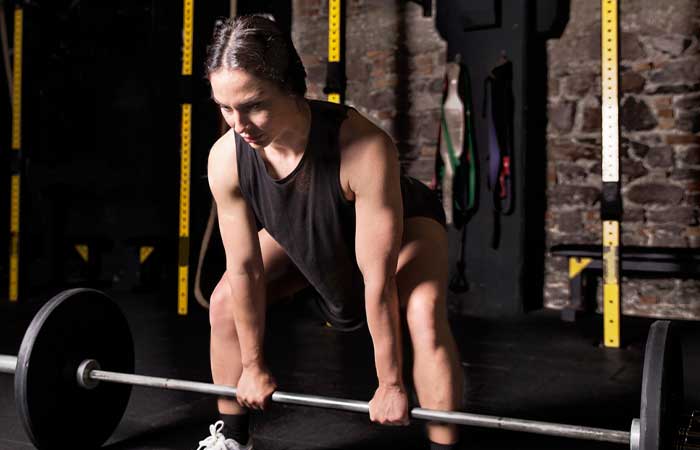
- Position your feet slightly wider than your hips.
- Point your toes out slightly.
- Keeping this wide stance intact, bend down, and grip the barbell with your hands inside of your legs.
- Make sure to keep your spine straight.
 Quick Tip
Quick TipStep 3: Lift The Barbell

- Once you grip the barbell firmly, tighten your core, legs, and butt, and straighten your back.
- Next, engage all your muscles, slightly pull the barbell, and push the floor with your legs.
- Now inhale and lift the barbell off the ground by extending your hips and knees.
Step 4: Stand Upright
- Once the barbell passes your knees, thrust your hips forward, and lift until your legs are fully extended and you stand upright.
- Ensure your back is straight and avoid shrugging your shoulders at the top.
- Finish the deadlift by exhaling and slowly lowering the barbell back down to the starting position.
To practice the sumo deadlift technique, do 4-6 sets of 2-4 reps using light weights. Once you perfect the form, move on to 3-5 sets of 3-5 reps with challenging weights.
Robyn Reed, a blogger, tried sumo deadlifts and shared her experience on her personal blog: “I feel super comfortable doing sumo deadlifts, and I can tell I’ll be able to move up in weight a little quicker than usual. I incorporate sumo DL’s into all my back workouts, and I ALWAYS do them at the beginning of my workouts because deadlifts take a lot of energy out of you, and you want to make sure you do the heaviest workouts first (i)!”
Now that you know how to do sumo deadlifts, let us take a look at some of the variations you can try.
Sumo Deadlift Variations
While sumo deadlifts are not very customizable, you can tweak them to fit your training needs. Here are some variations to make this lift work better for you.
Sumo Deadlift High Pull
Instead of standing up with a barbell in a sumo stance, hoist it higher during the sumo deadlift high pull. The movement of the exercise can help you transfer power from your lower body through the upper body and into the weight you are lifting. Especially the lower body exercises provide an extensive range of motion that eventually works on the hamstrings, glutes, quadriceps, biceps, and forearm muscles.
Kettlebell Sumo Deadlift
As the name suggests, this variation requires using a kettlebell instead of a barbell. It is the best variation for anyone who is just starting deadlifts. This exercise can help you master the basic movement and skills needed to perform sumo deadlifts. It can also boost muscular endurance and basic strength for lifting heavier loads.
Dumbbell Sumo Deadlift
The sumo deadlift with dumbbell variation uses less stable and significantly lower weights during the process. It engages the upper and mid back muscles and reduces the strain on the lower back. If you are looking for a beginner-friendly deadlift exercise, try this one with lower weights, and adjust your form to perform the sumo deadlift eventually.
Deficit Sumo Deadlift
This variation requires you to stand on an elevated platform to perform a lift. It means you must hold and pull the weight from a long distance and for a longer time than if you were standing on the ground. Thus, it helps you get up quickly during the lift from the squat position. It also improves hip and lower back and leg strength. The variation can be further modified in terms of the weights you use. Lower the elevation a little if you use heavier weights.
Smith Machine Sumo Deadlift
A machine used for barbell strength training can be a great way to perform sumo deadlifts in a controlled fashion. This variation allows the lifter to lift heavier weights than they could with a barbell. It also helps you activate more muscle fibers and work your glutes and hamstrings without injuring your spine.
Sumo deadlifts have various benefits. We have discussed the most important of those in the section below.
Benefits Of Sumo Deadlifts
They Are A Compound Movement
Compound movements are those that involve multiple muscle groups. Sumo deadlifts target many muscles, from the glutes and quads to your lower and upper back. The lifts require more energy from the body during the moment and are effective for lean tissue growth, better strength, and muscle building.
They Are Kinder On The Back
Unlike conventional deadlifts, sumo deadlifts put less pressure on the lumbar spine. This happens because the back is nearly erect while being directly supported by the legs and core during the lift. With the legs taking the strain off the spine, there is a lesser risk of back injury.
They Build Muscles And Strength
Sumo deadlifts are perfect for building muscle and strength if you incorporate them correctly into your workout routine. These target the quadriceps, glutes, hamstrings, and calves to develop leg and back muscles that can help you lift maximum loads. Along with this, sumo deadlifts also improve conventional deadlift moments.
They Improve Posture
Sumo deadlifts are an excellent choice for people with bone structures unsuitable for traditional deadlifts and back or flexibility issues. The moment provides a lot of freedom and efficiency and simultaneously works on improving posture and lower back strength. This happens due to the wider stance and strong thoracic extension required during the exercise.
They Hit The Quads And Glutes Better
The wide stance and positioning of the legs and feet target the quads and glutes better than a standard deadlift. Research suggests that signals between the muscles and motor neurons are significantly more from the upper leg muscles during sumo deadlifts (1). Hence, these lifts are ideal for those wanting to target these muscles. And if you don’t want to directly jump into this exercise, you can start slow with resistance training first. It will help you develop your body and warm you up for these Sumo deadlifts.
While sumo deadlifts have a lot of benefits, you may not reap all of them if you are doing them wrong. Let us take a look at the common mistakes and how you can avoid them.
Most Common Mistakes In Sumo Deadlifts
Not Warming Up Enough
It is necessary to devise a routine with the deadlift in mind. For instance, stretching might be more efficient for improving stability during a deadlift (3). So, incorporate multiple steps instead of doing a short, 5-minute warm-up routine. Ensure your warm-up routine has four components:
- A general warm-up
- Mobility exercises
- Stretching exercises
- Activation exercises
This extra 10-15 min routine will ensure your body is fully prepared to perform at its best with minimal risk of injury.
Not Breathing Properly
The key to doing sumo deadlifts well is by keeping your core engaged. It is possible only if you practice proper breathing during the lift. Start with a deep inhalation before picking the barbell off the ground. You do not have to inhale or exhale actively during the lift. Instead, hold your breath and only exhale when returning to the starting position.
Not Practicing Correct Form
Another mistake you might make during the exercise is not paying attention to your form. For instance, you may be rounding or arching your back during the lift. Avoid starting by lifting your hips first to ensure this does not happen. Instead, keep your shoulder blades back and your hips down. This will help you raise the bar close enough to pick it up naturally without bending your back.
Not Choosing The Right Stance
Our bodies come in different sizes and proportions. Therefore, a one-size-fits-all approach is unsuitable when it comes to sumo deadlifts. Answer these questions before you decide to do the sumo stance:
- Should I do sumo or conventional deadlifts?
- How wide should my sumo stance be?
- How narrow should my conventional stance be?
The answer to all these questions lies in the size and proportion of your body. Usually, people with relatively longer torsos may gain an advantage from sumo deadlifts (4). Further, a too-wide or too-narrow stance can make it difficult to activate the right muscles for the lifts.
 Quick Tip
Quick TipThese are the mistakes to avoid while doing sumo deadlifts. But what if you do not want to do them in the first place? Well, there are some alternatives you can look at.
Sumo Deadlifts Alternatives
Are you bored of doing the same sumo deadlift again and again? Here are some alternatives you might want to know about.
Trap Bar Deadlift

Trap bar deadlifts can also take the stress off your lower back. These act as a hybrid between deadlifts and traditional squats to give you the best of both worlds. You can include these gym workouts in your fitness routine to work the posterior chain muscles and quads.
Clean Deadlift
The clean deadlift is a common Olympic weightlifting training exercise. Stand up with the barbell and hoist it onto your shoulders. This way, you work the glutes, hamstrings, and quadriceps to a great extent.
Tire Flip
This exercise may look different from your regular deadlift. However, this conventional move packs a lot of power and strength. The force applied is both vertical and horizontal, unlike sumo deadlifts. While the technique of tire flips is different, no other exercise can replicate the brute strength required in a sumo deadlift like these.
Sumo deadlifts and conventional deadlifts are both effective compound exercises. However, they differ from each other greatly. Let us compare the two in the next section.
Sumo Deadlifts Vs. Conventional Deadlifts
Unlike sumo deadlifts, conventional deadlifts require a hip-width stance with your feet pointing forward. This narrow stance forces you to keep your hands outside your legs to grip the barbell. Further, you may even use a mixed grip (one overhand, one underhand) instead of a double overhand grip.
Conventional deadlifts, unlike sumo deadlifts, place more stress on the lower back. They also target the hamstrings and glutes to a significant extent. You can choose any of these two types of deadlifts depending on your fitness level and personal preference. For instance, you can opt for sumo deadlifts if you wish to work on your quads or choose the conventional version to activate your hamstrings.
Infographic: Everything You Need To Know About Sumo Deadlifts
If you need an exercise that targets various muscle groups, sumo deadlifts are for you. These keep your core engaged while targeting the quads, glutes, inner thighs, and hamstrings. They are the perfect exercise for improving hip mobility, flexibility, and lifting without straining the back. Check out the infographic below to learn more about this fantastic deadlift variation.

Illustration: StyleCraze Design Team
Whether you are a beginner or a fitness pro, sumo deadlifts are perfect for your needs. These work various back and leg muscles and build a more muscular back, increase your strength, and improve your posture. While this deadlift variation is not completely customizable, you can still try variations. However, ensure your form is correct while performing these deadlifts. Further, the weight you use to perform the deadlift should be challenging but just right to keep your stability during the movement. This will allow you to practice this strength-training exercise with minimal risk of joint injuries.
Frequently Asked Questions
Are sumo deadlifts better than squats?
Yes, sumo deadlifts are better than squats. While squats only boost glute and quad strength, sumo deadlifts also target the inner thigh muscles and allow you to lift heavier.
How many times a week should you do a sumo deadlift?
Since sumo deadlifts require you to lift heavy, limit them to 1-2 times per week. This will help prevent fatigue and joint injuries.
Are sumo deadlifts better than running?
Running is a form of cardio, whereas sumo deadlifts are a part of strength training. Therefore, sumo deadlifts are a better choice if you want to gain strength and burn more calories.
Are sumo deadlifts easier?
Since sumo deadlifts have a shorter range of motion, they are easier to perform than conventional deadlifts.
Key Takeaways
- Sumo deadlifts use a broader foot stance and toes pointing slightly outwards, similar to that of a sumo wrestler.
- They work on major muscle groups like the glutes, quadriceps, upper and lower back, and hamstrings.
- You can tailor sumo deadlifts to fit your training needs with variations like kettlebell and smith machine sumo deadlifts.
- They release strain from the lumbar spine, reduce the risk of back injuries, and help you lift better.

Image: Stable Diffusion/StyleCraze Design Team
Learn how to do the sumo deadlift with this easy-to-follow tutorial video. Click on it and get tips to perfect your form and incorporate heavier weights while performing the lift.
Personal Experience: Source
StyleCraze's articles are interwoven with authentic personal narratives that provide depth and resonance to our content. Below are the sources of the personal accounts referenced in this article.
i. Deadlifts—-the KING/QUEEN of all workouts;https://luv2befit.wordpress.com/2014/09/16/deadlifts-the-kingqueen-of-all-workouts/
References
Articles on StyleCraze are backed by verified information from peer-reviewed and academic research papers, reputed organizations, research institutions, and medical associations to ensure accuracy and relevance. Read our editorial policy to learn more.
- An electromyographic analysis of sumo and conventional style deadlifts
https://pubmed.ncbi.nlm.nih.gov/11932579/ - Lumbar spine loads during the lifting of extremely heavy weights
https://pubmed.ncbi.nlm.nih.gov/1758295/ - Effects of stretching and warm-up routines on stability and balance during weight-lifting: a pilot investigation
https://www.ncbi.nlm.nih.gov/pmc/articles/PMC4326506/ - Anthropometrical Determinants of Deadlift Variant Performance
https://www.ncbi.nlm.nih.gov/pmc/articles/PMC6683626/






